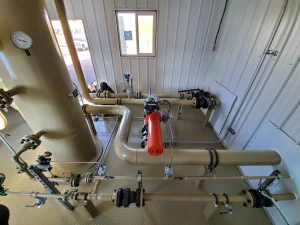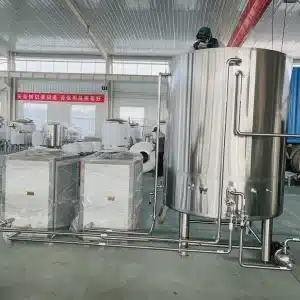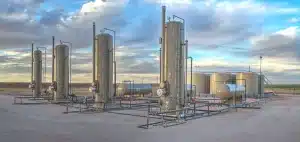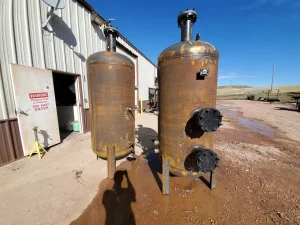
An overview of how are Pressure Vessels Fabricated
Pressure vessels are enclosed containers designed to hold gases or liquids at a pressure substantially different from the ambient pressure. These structures are built with precision to ensure that they can safely contain the high or low pressures of the substances they hold. The importance of pressure vessels cannot be understated, as they play a pivotal role in numerous industries, ensuring processes run smoothly and safely.
Primary Functions of Pressure Vessels:
- Containment: A pressure vessel’s main job is to contain a substance and prevent it from escaping into the surrounding environment. This containment protects both safety and the integrity of the process it supports.
- Pressure Regulation: Engineers design pressure vessels to maintain specific pressure levels by increasing or decreasing internal pressure as needed. This control helps the substances stay in their intended state, whether that’s liquid, gas, or supercritical fluid.
- Heat Transfer: Some pressure vessels—especially heat exchangers—transfer heat into or out of the substance inside. This role is essential in any process that requires material heating or cooling.
Different Types of Pressure Vessels:
- Storage Vessels: These vessels primarily store liquids or gases. You’ll find them in places like refineries (for oil), hospitals (for oxygen), or breweries (for beer).
- Heat Exchangers: These pressure vessels transfer heat between two or more fluids. They play a key role in industries such as power generation, moving heat from a primary to a secondary loop.
- Separators: These vessels separate different components within a mixture. In the oil and gas sector, for example, separators divide crude oil into parts like oil, gas, water, and sediments.
- Reactors: Reactors carry out chemical reactions under high pressure and temperature. Engineers design them to handle not only heat and pressure but also the reactive nature of the substances inside.
- Boilers: Boilers heat water to produce steam, which drives turbines and generates electricity. You’ll find them in almost every power plant.
Materials Used in Pressure Vessel Fabrication
Common Materials
- Carbon Steel: A popular choice for many pressure vessels, carbon steel offers a balance of strength and ductility. Its cost-effectiveness makes it a go-to option for larger vessels that don’t require resistance to corrosion or extreme temperatures.
- Stainless Steel: Known for its corrosion resistance, stainless steel is often used in applications where the vessel will be exposed to corrosive chemicals or environments. Its strength and durability make it a preferred choice for many industrial applications.
- Aluminum: Lightweight and resistant to corrosion, aluminum is used in specific applications where weight is a concern. It’s also known for its excellent thermal conductivity, making it ideal for heat exchangers.
- Nickel Alloys: These are used in situations that demand high resistance to temperature and corrosion. Nickel alloys are especially suited for extreme conditions, such as those found in the petrochemical industry.
Factors Influencing Material Choice
Selecting the right material for a pressure vessel is crucial, as it directly impacts the vessel’s performance, safety, and lifespan. Here are the primary factors considered:
- Temperature: The operating temperature of the vessel will influence the material choice. For instance, nickel alloys might be chosen for high-temperature applications, while aluminum is suitable for moderate temperatures.
- Pressure: The internal or external pressure a vessel will be subjected to determines the material’s required strength. High-pressure applications often lean towards robust materials like carbon or stainless steel.
- Chemical Compatibility: The contents of the vessel play a significant role in material selection. If the vessel will hold or be exposed to corrosive chemicals, materials like stainless steel or nickel alloys, known for their corrosion resistance, are preferred.
Design and Engineering
Importance of Design in Ensuring Vessel Integrity and Safety
The design phase is paramount in determining the vessel’s ability to withstand internal and external pressures, temperature fluctuations, and chemical reactions. A well-designed pressure vessel ensures that it can operate under its intended conditions without failure. This is not just about the vessel’s efficiency but, more importantly, about the safety of the environment and the people around it. An improperly designed vessel can lead to catastrophic failures, resulting in injuries, loss of life, and significant property damage.
Standards and Codes Governing Pressure Vessel Design
To ensure the highest level of safety and reliability, engineers design pressure vessels according to specific standards and codes. One of the most widely recognized standards worldwide is the American Society of Mechanical Engineers Boiler and Pressure Vessel Code (ASME BPVC). This code offers clear guidelines for designing, fabricating, testing, and inspecting pressure vessels. By following these standards, industry professionals can ensure that vessels meet strict safety requirements and reduce the risk of failure.
Computer-Aided Design (CAD) and Its Role in Modern Vessel Fabrication
In today’s digital age, engineers use Computer-Aided Design (CAD) to transform how they create pressure vessels. CAD enables them to build detailed 3D models, visualize the vessel’s structure, analyze stress points, and make adjustments before starting fabrication. This process not only speeds up design but also boosts accuracy. Engineers can simulate real-world conditions to ensure that each design performs efficiently and safely. They can also integrate CAD files directly with machinery during fabrication, which improves precision and lowers the margin of error.
Fabrication Processes
Cutting and Shaping
The fabrication process begins with cutting and shaping the material to meet specific design requirements. Engineers select the method based on the material type and the level of precision needed:
- Plasma Cutting: Technicians use a plasma torch to cut through materials like steel, stainless steel, and aluminum. This method delivers high accuracy and can handle thick materials effectively.
- Water Jet Cutting: Engineers use a high-pressure stream of water—sometimes mixed with abrasive substances—to slice through materials without generating heat. This method works especially well for heat-sensitive materials.
- Shearing: Operators make straight-line cuts with machines that apply force, avoiding the use of heat or the creation of chips.
Forming
After shaping the materials, technicians form them into the required shape of the pressure vessel using these methods:
- Rolling: Workers pass the material through rollers to create the desired curve.
- Bending: They bend the material using press brakes to achieve specific angles or contours.
- Dishing: Technicians form the end caps or heads of the vessel through a controlled pressing process.
Welding
Technicians then join the formed pieces using welding—a vital step for building a strong, safe vessel. Depending on the requirements, they apply various methods:
- TIG (Tungsten Inert Gas) Welding: Technicians use this precise method for critical welds where purity and accuracy matter most.
- MIG (Metal Inert Gas) Welding: This faster technique works well for thicker materials and longer seams.
- Submerged Arc Welding: Operators apply this method for very thick materials, feeding a continuous electrode and forming an arc beneath a protective layer. Inspectors check the welds thoroughly to ensure they meet quality standards and maintain vessel integrity.
Heat Treatment
After welding, technicians often perform heat treatment to strengthen the vessel and improve its mechanical properties:
- Stress Relieving: This step reduces internal stresses caused by forming or welding.
- Normalizing: Workers heat the material and let it cool in air to unify its microstructure.
- Tempering: They reheat the material to a controlled temperature, then cool it (usually in air) to reach the desired toughness and strength.
Testing and Inspection
Quality and safety depend on rigorous testing and inspection of the pressure vessel. Engineers apply various methods to ensure performance under pressure:
- Non-destructive Testing (NDT): These techniques check the vessel for flaws without damaging it. Common NDT methods include:
- Ultrasonic Inspection: Technicians use high-frequency sound waves to detect internal flaws.
- Radiographic Inspection: Inspectors apply X-rays or gamma rays to view the vessel’s internal structure.
- Magnetic Particle Inspection: This method reveals surface and near-surface flaws in ferromagnetic materials.
- Hydrostatic and Pneumatic Testing: Engineers fill the vessel with liquid or gas at specified pressures to confirm it can safely hold its intended contents without leaking or failing.
Surface Treatment and Finishing
Purpose of Surface Treatment and Finishing:
Engineers apply surface treatment and finishing to improve both durability and appearance:
- Corrosion Resistance: Corrosion threatens the vessel’s integrity, especially in harsh environments. Applying proper surface treatment creates a protective barrier that shields the vessel from corrosive elements.
- Aesthetics: While engineers prioritize safety and function, they also value appearance—especially when vessels operate in visible locations. A polished finish reflects professional workmanship.
- Surface Cleanliness: Clean surfaces are essential in industries like food processing and pharmaceuticals. Technicians ensure all vessels remain free of contaminants that could compromise their contents.
Methods of Surface Treatment and Finishing:
- Painting: This is one of the most common methods used. Painting not only provides a layer of protection against corrosion but also allows manufacturers to customize the appearance of the vessel. Specialized paints can also offer additional benefits, such as resistance to high temperatures or specific chemicals.
- Galvanizing: This process involves applying a protective zinc coating to the vessel. The zinc acts as a sacrificial anode, preventing rust from forming on the vessel itself. Galvanized vessels are known for their shiny, silvery appearance and are especially popular for outdoor applications due to their enhanced corrosion resistance.
- Shot Blasting: Before any treatment can be applied, the surface of the vessel needs to be clean and free from any impurities. Shot blasting is a method where small metal or mineral particles are propelled at the vessel’s surface. This not only cleans the surface but also creates a rough texture, which can enhance the adhesion of paints or coatings.
Need a reliable partner?
Red River specializes in the design and manufacturing of pressure vessels. We also fabricate related items such as prefabricated spools and skid packages.
Reach Out to us today and experience the Red River difference. Where American Made and American Values come together, we care more.
FAQ: Pressure Vessel Fabrication
What materials are commonly used in the fabrication of pressure vessels, and how are they selected?
Engineers choose materials such as carbon steel, stainless steel, aluminum, and nickel alloys based on application, pressure, fluid type, and temperature. These materials must withstand high pressure and, in some cases, corrosive conditions. The selection ensures long-term durability and compliance with industry standards.
How do manufacturers ensure the safety and integrity of pressure vessels during fabrication?
Manufacturers strictly follow standards like the ASME BPVC and apply rigorous testing methods such as X-ray inspection, ultrasonic testing, and hydrostatic testing. These procedures identify defects early and confirm that the vessel can endure operational stress and environmental challenges.
What are the steps involved in the fabrication process of a pressure vessel?
The process includes design and engineering, material selection, cutting and forming, welding, and inspection. Engineers apply modern techniques like robotic welding and CNC cutting to boost precision, efficiency, and compliance with safety regulations.
Can pressure vessels be customized to meet specific operational requirements?
Yes. Engineers can customize vessels by adjusting shape, material, thickness, and adding features like nozzles, manways, or supports. Custom fabrication ensures the vessel suits the unique demands of industries such as oil and gas, chemicals, or pharmaceuticals.
What are the challenges in the fabrication of pressure vessels for extreme conditions, and how are they addressed?
Fabricating pressure vessels for extreme conditions, such as high temperatures, corrosive environments, or very high pressures, presents challenges in material selection, design, and construction. Addressing these challenges involves using high-grade materials that can withstand the conditions, such as corrosion-resistant alloys for corrosive environments. Advanced design techniques, including finite element analysis, help in predicting how the vessel will behave under extreme conditions. Furthermore, rigorous testing under simulated operational conditions ensures the vessel’s performance and safety before deployment.
Related Blog Post

Understanding Different Types of Failure in Pressure Vessels

The Most Common Type of Pressure Vessel Used in Industry


Understanding Adsorption Air Dryers

Types of Failure in Pressure Vessels
No pillar keyword set for this post.
